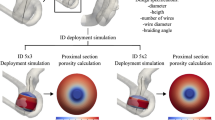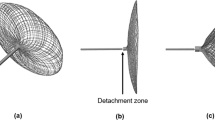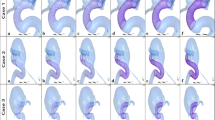Abstract
Purpose
The internal carotid artery (ICA) is a region with a high incidence for small- and medium-sized saccular aneurysms. However, the treatment relies heavily on the surgeon’s experience to achieve optimal outcome. Although the finite element method (FEM) and computational fluid dynamics can predict the postoperative outcomes, due to the computational complexity of traditional methods, there is an urgent need for investigating the fast but versatile approaches related to numerical simulations of flow diverters (FDs) deployment coupled with the hemodynamic analysis to determine the treatment plan.
Methods
We collected the preoperative and postoperative data from 34 patients (29 females, 5 males; mean age 55.74 ± 9.98 years) who were treated with a single flow diverter for small- to medium-sized intracranial saccular aneurysms on the ICA. The constraint-based virtual deployment (CVD) method is proposed to simulate the FDs expanding outward along the vessel centerline while be constrained by the inner wall of the vessel.
Results
The results indicate that there were no significant differences in the reduction rates of wall shear stress and aneurysms neck velocity between the FEM and methods. However, the solution time of CVD was greatly reduced by 98%.
Conclusion
In the typical location of small- and medium-sized saccular aneurysms, namely the ICA, our virtual FDs deployment simulation effectively balances the computational accuracy and efficiency. Combined with hemodynamics analysis, our method can accurately represent the blood flow changes within the lesion region to assist surgeons in clinical decision-making.






Similar content being viewed by others
Data availability
Data are available from the corresponding author upon reasonable request.
References
Bouillot P, Brina O, Ouared R, Yilmaz H, Farhat M, Erceg G, Lovblad KO, Vargas MI, Kulcsar Z, Pereira VM (2016) Geometrical deployment for braided stent. Med Image Anal 30:85–94
Bouillot P, Brina O, Yilmaz H, Farhat M, Erceg G, Lovblad KO, Vargas M, Kulcsar Z, Pereira V (2016) Virtual-versus-real implantation of flow diverters: clinical potential and influence of vascular geometry. Am J Neuroradiol 37(11):2079–2086
Chancellor B, Raz E, Shapiro M, Tanweer O, Nossek E, Riina HA, Nelson PK (2020) Flow diversion for intracranial aneurysm treatment: trials involving flow diverters and long-term outcomes. Neurosurgery 86(Supplement–1):S36–S45
Dobrocky T, Matzinger M, Piechowiak EI, Kaesmacher J, Pilgram-Pastor S, Goldberg J, Bervini D, Klail T, Pereira VM, Z’Graggen W et al (2023) Benefit of advanced 3D DSA and MRI/CT fusion in neurovascular pathology. Clin Neuroradiol 1–8
Frösen J, Cebral J, Robertson AM, Aoki T (2019) Flow-induced, inflammation-mediated arterial wall remodeling in the formation and progression of intracranial aneurysms. Neurosurg Focus 47(1):E21
Gory B, Berge J, Bonafé A, Pierot L, Spelle L, Piotin M, Biondi A, Cognard C, Mounayer C, Sourour N et al (2019) Flow diverters for intracranial aneurysms: the diversion national prospective cohort study. Stroke 50(12):3471–3480
Guédon A, Thépenier C, Shotar E, Gabrieli J, Mathon B, Premat K, Lenck S, Degos V, Sourour N, Clarençon F (2021) Predictive score for complete occlusion of intracranial aneurysms treated by flow-diverter stents using machine learning. J Neurointerv Surg 13(4):341–346
Izzo R, Steinman D, Manini S, Antiga L (2018) The vascular modeling toolkit: a python library for the analysis of tubular structures in medical images. J Open Source Softw 3(25):745
Leng X, Wang Y, Xu J, Jiang Y, Zhang X, Xiang J (2018) Numerical simulation of patient-specific endovascular stenting and coiling for intracranial aneurysm surgical planning. J Transl Med 16(1):1–10
Li CZ, Liu RQ, Zhong HX, Fan JM, Si WX, Zhang M, Heng PA (2023) Semi-supervised intracranial aneurysm segmentation from CTA images via weight-perceptual self-ensembling model. J Comput Sci Technol 38(3):674–685
Ma D, Dumont TM, Kosukegawa H, Ohta M, Yang X, Siddiqui AH, Meng H (2013) High fidelity virtual stenting (HIFIVS) for intracranial aneurysm flow diversion: in vitro and in silico. Ann Biomed Eng 41:2143–2156
Ogilvy CS, Chua MH, Fusco MR, Reddy AS, Thomas AJ (2015) Stratification of recanalization for patients with endovascular treatment of intracranial aneurysms. Neurosurgery 76(4):390
Ou C, Hou X, Duan CZ, Zhang X, Chong W, Qian Y (2021) Flow diverter modeled as heterogeneous and anisotropic porous medium: simulation, experimental validation and case analysis. J Biomech 123:110525
Paliwal N, Yu H, Xu J, Xiang J, Siddiqui AH, Yang X, Li H, Meng H (2016) Virtual stenting workflow with vessel-specific initialization and adaptive expansion for neurovascular stents and flow diverters. Comput Methods Biomech Biomed Engin 19(13):1423–1431
Ravindran K, Casabella AM, Cebral J, Brinjikji W, Kallmes DF, Kadirvel R (2020) Mechanism of action and biology of flow diverters in the treatment of intracranial aneurysms. Neurosurgery 86(Suppl 1):S13
Ruan X, Yuan W, Hu Y, Li J, Wu W, Xia R (2020) Chiral constrained stent: Effect of structural design on the mechanical and intravascular stent deployment performances. Mech Mater 148:103509
Sarrami-Foroushani A, Lassila T, MacRaild M, Asquith J, Roes KC, Byrne JV, Frangi AF (2021) In-silico trial of intracranial flow diverters replicates and expands insights from conventional clinical trials. Nat Commun 12(1):3861
Wu X, Tian Z, Liu J, Li W, Chen J, Zhou Y, Yang X, Mu S (2019) Hemodynamic impacts of flow diverter devices on the ophthalmic artery. J Transl Med 17(1):1–7
Závodszky G, Csippa B, Paál G, Szikora I (2020) A novel virtual flow diverter implantation method with realistic deployment mechanics and validated force response. Int J Numer Methods Biomed Eng 36(6):e3340
Zhang X, Wu D, Miao F, Liu H, Li Y (2020) Personalized hemodynamic modeling of the human cardiovascular system: a reduced-order computing model. IEEE Trans Biomed Eng 67(10):2754–2764
Funding
The work was partially supported by a grant from the Research Grants Council of the Hong Kong Special Administrative Region, China (Project Reference Number: T45-401/22-N), in part by grants from National Natural Science Foundation of China (62372441, U22A2034, 82302300), in part by Guangdong Basic and Applied Basic Research Foundation (2023A1515030268), in part by Shenzhen Fundamental Research Program (JCYJ20200109110420626) and in part by Guangzhou Municipal Key R &D Program (2024B03J0947).
Author information
Authors and Affiliations
Contributions
ZL and MZ designed and carried out the experiments as well as wrote the manuscript. CW, ZW and CO collected and analyzed the data. XL and WS supervised the project.
Corresponding authors
Ethics declarations
Conflict of interest
We have no conflicts of interest to declare.
Ethics approval
All patients data were collected retrospectively with informed patient consent and approval from the institutional ethics review board.
Consent for publication
We consent to the publication of this article in IJCARS.
Code availability
Our code will be available on request.
Additional information
Publisher's Note
Springer Nature remains neutral with regard to jurisdictional claims in published maps and institutional affiliations.
Appendix A: Patients’ data description
Appendix A: Patients’ data description
See Table 3.
The summary of baseline characteristics is presented in Table 4. Among the 34 patients, 5 cases (14.7\(\%\)) were male, with an average age of 54.97 ± 9.98 years. 29 cases were female, with an average age of 60.20 ± 13.03 years. 12 cases (35.3\(\%\)) had ophthalmic artery IA and 22 cases (64.7\(\%\)) had communicating artery IA. The mean aneurysm size, mean parent diameter and mean follow-up time were 5.89 ± 2.11 mm, 4.03 ± 0.60 mm and 7.74 ± 2.14 months, respectively. Among them, 28 cases were completely occluded, and 6 cases had residual neck.
Rights and permissions
Springer Nature or its licensor (e.g. a society or other partner) holds exclusive rights to this article under a publishing agreement with the author(s) or other rightsholder(s); author self-archiving of the accepted manuscript version of this article is solely governed by the terms of such publishing agreement and applicable law.
About this article
Cite this article
Liu, Z., Zhang, M., Wang, C. et al. Flow diverters treatment planning of small- and medium-sized intracranial saccular aneurysms on the internal carotid artery via constraint-based virtual deployment. Int J CARS (2024). https://doi.org/10.1007/s11548-024-03124-z
Received:
Accepted:
Published:
DOI: https://doi.org/10.1007/s11548-024-03124-z




